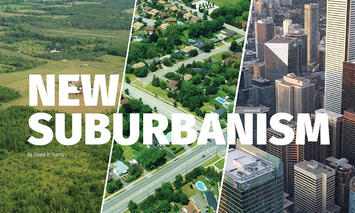
New Suburbanism advances a set of ideas to deepen the conversation about the synergistic relationship between core areas, suburbs, and rural areas. It challenges the prevailing ideology that density is a virtue. It appeals for an update of planning practice, given the pandemic push and new technology pull. A set of actionable ideas referred to as the Elements of New Suburbanism are presented.
Eight years ago, a group of independent planners and architects residing in Scarborough, ON were convened by a community organization to discuss why this suburban and racialized part of the City of Toronto was declining while the core of the city was thriving. We observed old suburban hospitals with overcrowded emergency rooms, declining job growth, little higher-order public transit, and increasing poverty, while Toronto’s higher income, white, urban core enjoyed strong investment in institutions, arts and cultural establishments, modern hospitals, public transit, universities, and world-scale businesses.
With 630,000 people, Scarborough has a large population and is one of the most ethnically and culturally diverse areas in North America. The student planners among us wondered why they weren’t learning more about suburbs in school, given that most people in North America live in suburbs and love living there.
New thinking on the suburbs
In 2016, we launched the Institute for New Suburbanism (INS) as a forum for dialogue on suburban planning, design, and development (www.newsuburbanism.ca). The INS is a Scarborough-based think-tank that promotes dialogue about the suburbs and metropolitan centres, and how these communities interact. It is a small, nimble, informal organization of planners who have met on-line monthly since the start of the COVID-19 pandemic.
Our mission involves critically examining the dominant planning ideology according to which density is a virtue that can solve most problems, including everything from car dependency to loss of farmland and municipal infrastructure debt. In this fixation on density, we saw that planners and architects were missing opportunities to enhance sustainable, climate-supportive suburban landscapes, advance progressive architecture and invest in suburban arts and culture. The success of Scarborough’s The Weeknd, (a globally recognized singer headlining at the 2021 Superbowl half-time show) showed the significant suburban creativity that could be released.
Given that the world’s car and truck manufacturers are retooling to produce electric vehicles, we questioned the critique of suburbia as being necessarily linked to high vehicle carbon emissions. Countries such as France and Canada have policies to stop selling carbon emitting vehicles by 2040.
We also questioned entrenched ideas against greenfield development that appear to be hindering a full discussion of how we can achieve affordable housing. Further, we observed the migration of urban residents to rural areas, pointing to the need to plan for rural as we plan for urban. In sum, the planning profession is in the midst of disruptive and fundamental changes due to the pandemic push and technology pull affecting how we live in core, suburban, and rural areas, a transformation to which we need to pay attention.
Looking outward, we saw the need for investment, planning, and economic development in the inner and outer suburbs as well as in rural areas across the country. Hosting people from all over the world, the suburbs have become ethnically and culturally diverse. Yet, like Toronto’s suburbs, there is a rise of poverty in areas where the immigrant population was high. We concluded that there is a need to strengthen core, suburban, and rural communities – together – as an opportunity to improve how we plan our regions, an observation that contrasts with the conventional thinking that investments in the core trickle out to the suburbs and rural areas.
Our cities and regions need to make space for both single family suburban homes and higher density dwellings. As noted by Roger Keil, York University Research Chair in Global Sub/Urban Studies, times have changed:
The call for a renewed urban theory is once again before us today. The ‘explosion’ [of the historic city leading to the creation of the suburbs] was merely the starting gun of a much more far-reaching process of complete urbanization that turns the categories of geographical centre and periphery upside down and creates new relationships among various parts of urban regions.
So, we asked ourselves, could we identify and advocate for a better way to plan our core, suburban, and rural areas by looking at these systems synergistically?
After years of lectures, dialogue, and scholarship, we concluded that the idea of a ‘new suburbanism’ has merit; a school of thought that advocates for broader investment that is fairly distributed across core, suburban, and rural areas and sets aside ideological beliefs that discount suburban voices.
We developed a broad global network of practitioners and academics who share these beliefs. For example, the author of “New Suburbanisms,” Houston, TX. author and architect Judith K. De Jong was the first international speaker at the Institute. She observed:
Rather than seeking to replace suburban design or adopt urbanization, which I would argue is the philosophy of new urbanism thinking, New Suburbanism extends beyond the discipline of urban design and identifies pragmatic ways to build and improve suburban communities.
This excerpt is reprinted with permission of the Canadian Institute of Planners. Download the full report here.
Dave Hardy RPP, MCIP, is President of Hardy Stevenson and Associates Limited and is a Registered Professional Planner. He is also the Executive Director of the Institute for New Suburbanism.












